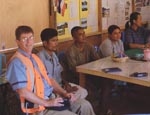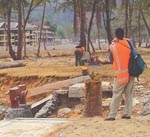PDF of this article (126 KB)

NIWA scientist Rob Bell first heard about the Indian Ocean tsunami on the news late on Boxing Day. As the coordinator of New Zealand’s sea-level network and a tsunami expert, he knew that he would be on call to answer tsunami questions from Government and the media. What he wasn’t expecting was to be sent to Thailand as part of a New Zealand reconnaissance mission to learn from the response to the Sumatra earthquake and resulting Indian Ocean tsunami. Rob Bell plays a key role in the Natural Hazards Centre, which is run jointly by NIWA and GNS (Institute of Geological and Nuclear Sciences). Water & Atmosphere caught up with Rob soon after his return from Thailand.
W&A – You were sent to Thailand from 23 January to 2 February. What was the purpose of your mission?
Rob – Primarily, our purpose was to assess the impact of a large tsunami on coastal communities that are similar to our own in New Zealand and bring back some lessons for our country. Thailand was selected because of its vibrant tourist sector and mix of modern and traditional infrastructure and buildings. The reconnaissance team members came from backgrounds in engineering, science, local government, and emergency management, and from a range of organisations including universities, crown research institutes, consultancies, and local councils. The mission was sponsored by the New Zealand Society for Earthquake Engineering (NZSEE) and the Earthquake Commission. Our team visited the main resort areas of the Andaman coast, including Phuket, Phi Phi Island, and Phang-Nga (Khao Lak).


W&A – And what will be the result?
Rob – The reconnaissance team will produce a report to the NZSEE and government officials on the lessons that can be applied to New Zealand. A roadshow will be presented in four cities with public sessions and media briefings. We will also present a seminar at the annual NZSEE Conference in Taupo in March.
W&A – Did you discover particular lessons for New Zealand?
Rob – Several. The damage to buildings from such a large tsunami was so catastrophic close to the coast that the key objective in reducing the impact of tsunamis must be saving lives. We need widespread and simple-to-follow warning systems, together with clear evacuation plans or places of refuge. People must be educated to recognise unusual ocean behaviour, like the sea rapidly retreating just before a tsunami. No single measure can provide complete protection – it needs to be a combination of early tsunami detection, multiple warning systems, evacuation plans, immediate response to the event, strengthening or alternative location of critical facilities (for example, Phi Phi Island hospital was totally destroyed), and wise long-term planning of coastal subdivisions (such as setbacks from the coast and sufficient access/escape routes).
W&A – How did you get into tsunami science?
Rob – It evolved from studying other coastal hazards like waves, storm surge, extreme tides, and coastal erosion – one must consider all these hazards, including tsunami, when planning coastal developments. So it’s a matter of starting with a specialty area in coastal physical sciences or engineering and broadening your knowledge from there through reading, seminars, attending conferences, running computer models, and measuring small tsunami (which we get more frequently in New Zealand – the most recent was on Christmas Eve).
W&A – What education or training prepared you for your work?
Rob – My university education in civil engineering provided a useful base to finding applied solutions to a range of technical challenges. In high school I focused on maths and physics and then did my BE (Hons) and PhD in Engineering at University of Canterbury. Since then I’ve worked 25 years in my profession. I’m looking forward to taking a sabbatical later this year in Canada and the US. I’ll be at the Institute of Ocean Sciences in Sidney, British Columbia. I’ll also spend time at the Pacific Marine Environment Lab in Seattle, Washington, where there is a strong programme in tsunami modelling.
You can read more about Rob’s coastal hazards research in “Wave-assisted coastal flooding”.
